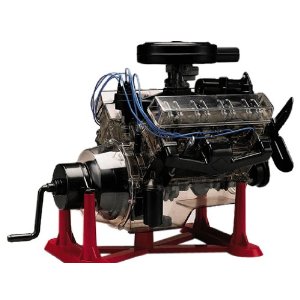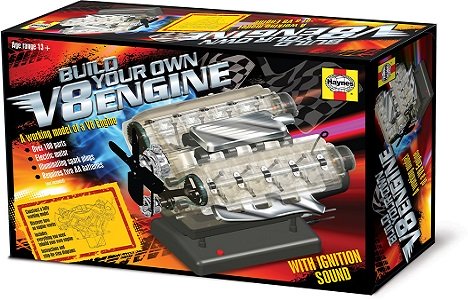
The working model car engine that I built as a kid, at eight years old, is still available today. They moved the recommended age group up to age 12.
I put this kit together 42 years ago and it started me down the career path I enjoy today. My shop teacher said, you can study all you want, but until you get your hands on an engine the level of understanding is only theory.
After assembling the big V8 motor I was hooked on all things automotive. Now at the ripe old age of 50 I’m a certified master technician that still assembles engines.
When my father bought me this plastic model engine, I’m sure he had no idea how it would impact my life in such a major way. The Revell company manufactured this 1:4 scale model back then. The same company makes it today. The difference between now and then is like many things it’s built in China.
This means it ships with metric screws and nuts that don’t fit very well into the holes drilled for American standard hardware that came with the model years ago. This makes it a little harder to assemble.
Also the quality of the casting doesn’t seem to be what it used to. I purchased this for my nephew and a neighbor’s kid and both of them said it needed some extra trimming and sanding of the rough edges.
You need the parts to fit perfectly and this will require some extra patients on the part of the builder. Parents can buy the standard size screws that the model came with years ago at local hardware stores.
You will need 34 2-56 nuts, 14 2-56 1/4 inch screws, 20 2-56 1/2 inch screws to replace the supplied metric nuts and screws. This upgraded hardware will only cost a few dollars. However, it will save you a lot of aggravation during the assemble process.
Revell isn’t the only company that makes a scaled automotive motor model kit. Although I have never assembled it, there is one available from the Smithsonian Company and two from Haynes.
They’re the people that write the shop service manuals. The big difference with the Smithsonian model car engine is its an in-line six cylinder where as the Revell model is the highly desirable V8 motor. I added a section below to talk about the interesting Haynes kits.
Plastic Engine Problems
Although my model lasted many years it eventually seized up. When I tried to force it, the plastic block cracked and it was completely destroyed.
An interesting difference between the modern kits and the one I had, was mine came with a battery powered electric motor. It looked like a starter. You pushed a button to turn the engine over.
The modern version has a hand crank on the flywheel that you use to manually turn the engine over. This could save the model from destruction down the road.
I saw an interesting note from someone else who put the newer kit together. They mentioned not to use vegetable oil as recommended by the instructions.
I believe this is what went wrong with my plastic V8 motor. The vegetable oil eventually degraded and acted on the plastic pieces. It turned milky making it harder to see inside, but also distorted the parts and caused the engine to seize or get stuck.
When you try to force it the brittle plastic will not endure much force. The note also stated that there is plastic safe lubricant available from a company called Labelle that’s in the model train business.
What can You Learn from the Model Kit
I’m not saying if you buy your kid this plastic model that he or she will become a certified master technician.
In fact, they probably won’t work on cars for the rest of their life like me or save you thousands on car repairs with pro bono maintenance and advice.
But even if this child becomes a professional athlete they will always know how the engine in their BMW operates and know exactly what happens when the key is turned. This can be a valuable life lesson for any age group, but again the kit is recommended for ages 12 and up.
One of the most impressive things to me is the physical size of the model which is 1:4 scale. It measures 22.2 inches in length by 16.6″ in width and 4.6″ in height.
And it weighs an impressive 3.6 lbs which is a lot for a plastic model. Although this thing won the 2008 Parents Choice Award you’ll have to remember that it’s hard to put together.
Some children may not think the award is deserved. With that said, I don’t know of a better way for kids or adults to learn how an internal combustion engine works.
The clear plastic lets you see all of the parts moving in unison just like the real thing. This gets the brain going, because not only can you see it, you can touch it.
The kit I put together needed several repairs over the years I owned it. This made me feel like a real mechanic. I had to use problem solving skills, diagnose and repair the plastic engine a few times.
A word about the Haynes model engine set. Reading through the feedback and comparing it to comments about the one made by Revelle culminates into an interesting dilemma. It sounds like the instructions provided with the Haynes kit is written in service manual format. This can enhance the learning experience. Although the Revelle model is less expensive the instructions aren’t so good.

If you don’t want to buy a model kit and would like the opportunity to learn more about this subject this next link will take you to my automotive engine section from this page about model car engines.
If you would like to learn more about the you fix cars website, this next link will take you to the homepage, where you can also find out how to get some one-on-one car repair help.

